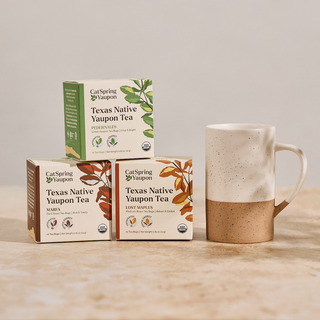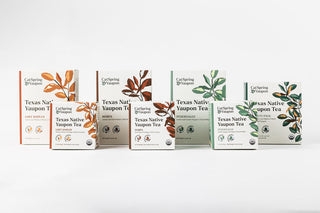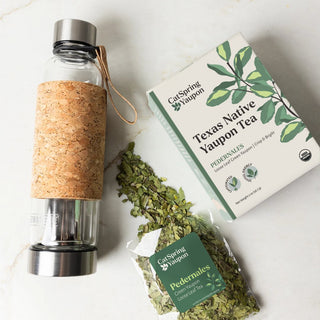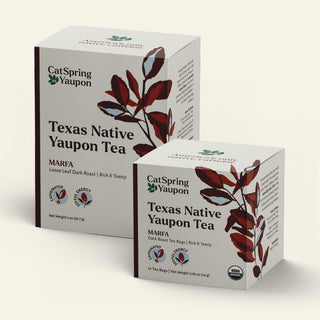
America's Only Native Caffeine
Yaupon (pronounced yō-pon) is brewed from the leaves of the yaupon holly (Ilex vomitoria), this smooth, naturally uplifting tea has been enjoyed for centuries and is now being rediscovered as a clean, sustainable alternative to coffee and imported teas.
Where Yaupon Tea Comes From
Yaupon is a species of holly native to the southeastern United States, particularly Texas and the Gulf Coast region. It grows as an evergreen shrub or small tree, well adapted to heat, drought, and poor soil conditions.
Because yaupon thrives naturally:
-
It does not require deforestation
-
It grows without added water
-
It supports healthy soil and biodiversity
This makes yaupon one of the most environmentally responsible caffeine sources available today.

What Makes Yaupon Tea Unique
Yaupon stands apart from other caffeinated drinks in a few key ways:
-
America’s only native caffeine
Yaupon is the only naturally caffeinated plant indigenous to North America. -
Smooth, steady energy
It contains a balanced combination of caffeine and other natural compounds that provide lift without the jitters or crash. -
Always smooth, never bitter
With little to no tannins, yaupon won’t turn bitter—even if over-steeped. -
Naturally resilient and sustainable
Yaupon grows wild without irrigation, pesticides, or fertilizers.
How Yaupon Tea Compares to Coffee and Green Tea
Unlike coffee, which can cause spikes and crashes, yaupon provides a clean, balanced, joyful energy. Its naturally occurring compounds work together to support steady focus and clarity:
-
Caffeine – present at lower, gentler levels than coffee, supporting alertness without overstimulation
-
Theobromine – a naturally occurring compound also found in chocolate, associated with mood support and long-lasting energy
-
No tannins – unlike traditional teas, yaupon can be steeped multiple times without becoming bitter or astringent
The result is a naturally uplifting tea that energizes without the downsides often associated with synthetic stimulants or highly concentrated caffeine sources.
Yaupon’s Indigenous and Cultural History
You may already have yaupon growing in your yard. Across the American South, it’s a common shrub—often used as a decorative plant—but this unassuming evergreen has a long and storied past.
Known as “the beloved tree” by the Cherokee, yaupon was brewed and shared by Indigenous communities more than a thousand years ago. It was widely traded along established routes, reaching as far north as present-day Illinois. Along the Texas coast, the Karankawa harvested and cherished yaupon before their communities were largely eradicated through colonization.

Colonization, forced removal, and the suppression of Indigenous knowledge disrupted these traditions. By the 19th century, imported teas—controlled through global trade networks like the East India Company—replaced yaupon in mainstream culture, while tribes such as the Chickasaw were displaced from their ancestral lands.
Yaupon briefly reappeared during times of scarcity, including the Civil War and World War II, when it was used as a local coffee substitute. Today, its return reflects a renewed appreciation for Indigenous knowledge, native plants, and traditions rooted in place.
Find more about this forgotten treasure in our award-winning animated video, showcased at the World Tea Expo:
Ready to Try Yaupon Tea?
Experience America’s only native caffeine—smooth, sustainable, and easy to brew.
Explore Our Yaupon Teas






